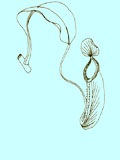

 |
 |
 |
Miscellany
| Historic coral find and a few lessons | |
| The significance of logan stones | |
| An unusual example of frugivory | |
| Temperate Feet in Tropical Waters | |
| By the way |
There is a wealth of historical information on local species and habitats buried in old government reports, journals, newspapers and books. If you find something which you think should be more widely known, send it in to us!
Historic
coral find and a few lessons
by
Yvonne Sadovy
History, of course, helps to put things into perspective.
I came across a 22-year old article from the South China Morning Post
recently (26th March, 1978). It reports on the discovery by Professor
(then a mere Reader) Morton and a team of divers of a large bed of living
coral - 'somewhere' in Mirs Bay. A couple of things struck me about this
article. The first was how much has been learned of the marine environment
of Hong Kong in the last few decades. For example, the article reports
that the British Museum, up until 30 years ago, did not even believe that
Hong Kong waters contained coral! We now know there are at least 53 species!
The second lesson is how long it takes to protect such treasures. The
'mystery' location was Chek Chau which was recommended for protection
following the 1978 discovery. Nearby Tung Ping Chau, similarly coral-endowed,
is only now being considered for marine protection. Chek Chau continues
unprotected.
The following are abstracts
from the original SCMP article:
“A Hong Kong University diving
team has discovered a massive bed of perfect coral which they say is comparable
to the best in Thailand or Singapore. They say the healthy coral, which
is alive with colour extends down to a depth of 10 meters and completely
circles a nearby island. But the name of the island in Mirs Bay is being
kept a closely-guarded secret until further studies by local and international
marine biologists is made.
The group’s leader, Dr Brian Morton, a reader in marine
biology at the university, said he also intends to notify the Government
of its existence. He said the “major discovery” was made early this week
“It is about 100 yards out from the shore and goes all the way round the
island. It is a perfect piece of coral and nobody knows about it”, he
said.”üü..
“It’s out there for the public
to see and enjoy and it should be preserved for future generations”, Dr
Morton said. He said the group will recommend the Government declare it
a protected area and turn it into a marine park.”üü..
“It was only seven years
ago that the British Museum refused to believe that Hongkong waters contained
coral. There has been little research into the substance and it was suspected
that there were only a few species of coral around”, he said.
| P.21 |
The
significance of logan stones
by
Skip Lazell
In the course of my investigations of island biology
I have repeatedly been faced with the question of what enables the survival
of relict populations of forest-adapted species on brutally deforested
land areas. The lands I have been especially interested in are aptly described
by Dudgeon & Corlett (1994: 15) as: "Granite hills... with a
surface cover of huge boulders exhumed as the weathered rock around them
is eroded." Specifically, where a forest relict species has turned
up in or close to ravine slopes into which the boulders had apparently
tumbled, and where the latter were typically perched on one another so
that damp, shady, almost cavernous recesses resulted. I thought forest-adapted
species might have survived in these recesses when all around was reduced
to grassland - or ashes. Initially, I called this the "boulder jumble"
theory.
When the time came to begin a formal write-up
of the fauna, however, I needed a somewhat more sophisticated characterization
of the geology involved. I asked
several prominent American geologists about my "boulder jumbles"
before I struck one who asked me if they might be core stones? Ah,
a key word, chink in the armour of ignorance. I began my computer
search.
The problem with a computer search is that those
who input the data and references often seem to act as though the printing
press was invented about 1990. The
beauty of it is that once the hare has started one can repair to the actual
(as opposed to virtual) library and follow it home. I was eventually led
back to David Linton who, in 1955, published The Paper That Explains Everything.
As noted by Dudgeon & Corlett (1994), most
of the southwestern third of the Hong Kong region is founded on a great
granitic Jurassic batholith: igneous, moulten granite that intruded beneath, but did not reach, the surface
before it solidified. Subsequent soil-building episodes produced laterite:
iron-rich, rust-red and acidic. Alternating cycles of erosion exposed
the granite. Meantime, seismic activity cracked the batholith both vertically
and horizontally. If we could back off far enough, and average the inclinations
of thousands of cracks, most would fall into two categories: radial cracks,
extending out from seismic centres, and horizontal cracks, parallel to
the curvature of the Earth's surface. Viewed up close, the radial cracks
appear vertical and the horizontal cracks appear straight, producing a
subrectilinear pattern of blocks. However, the lateritic matrix speeds
disintegration of the granite along the cracks and, especially, at their
junctions, thus eventually rounding off the corners.
When ultimately exposed by erosion on the hilltops
and along ridges, the subcubical blocks of old bedrock weather to subcircular,
ovoid or pyramidal shapes. Those that remain standing are called tors;
those that slump or roll away are called core stones; core
stones that have tumbled together - often cracking again to make half-spheroids
or half-ovoids - and are perched, are called logan stones.
A single logan stone cannot provide much of a refuge,
but a good-sized ravine or a real valley chock-a-block with them might
save a lot. Similarly, the likelihood of any species' survival in a logan
stone refugiurn is inversely proportional to the size of the organisms
in question. A hectare of logan stones will fail to save a viable population
of tigers, but quite a lot of rodents, insectivores and even small carnivores
might make it. Trees are unlikely to be saved in logan stone refugia,
but even a single tree can perpetuate a population (no one seems concerned
about inbreeding depression in trees).
To test my theory of logan stone refugia, I suggest
two complementary lines of investigation. First, locate sites dominated
by sizeable conglomerations of logan stones on likely islands and search
for relict forest animals. An especially likely field to search is the
Wanshan archipelago, stretching away to our south and west. There are
hundreds of islands out there, most quite uninvestigated biologically.
Second, extend the search to flora as well as fauna. If I am right, plants
- especially small, herbaceous species of the erstwhile forest floor should
have survived in logan stone refugia too. Such plants will predic-tably
be easier to find than are most kinds of animals. It would be especially
entertaining to develop a list of candidate species, perhaps based on
the known floras cited by Dudgeon & Corlett (1994) for Happy Valley
and Aberdeen, or that of Tai Po Kau, or even a distant site like Dinghushan.
With list in hand, let the hunt begin. Or, you can begin without it and
just be amazed by what you find. That has worked for the animals.
Bibliography
Dudgeon, D.
and Corlett, R. (1994). Hills and Streams - An Ecology of Hong
Kong. Hong Kong University Press.
| P.22 |
An
unusual example of frugivory
by
Richard Corlett
Between flights in Chicago, I spent a couple of hours
walking around the downtown area on a summer morning. In a lakeside park,
an ornamental plum species (Prunus sp.) had ripe fruit. Fallen
fruits were being eaten by European Starlings, Sturnus vulgaris,
Canada Geese, Branta canadensis, and Ring-billed Gulls, Larus
delawarensis. Most of the fruit-eating gulls were juveniles, while
most adults ignored them. Although this
behaviour may seem surprising for a seabird, Ring-billed Gulls
are common, resident scavengers in Chicago, and our own, winter-visitor,
Black-headed Gulls are known to sometimes eat fruit in their summer range,
including cherries (Prunus sp.), olives and Cinnamomum camphora
(Corlett, 1998).
| P.22 |
![]()
Temperate
Feet in Tropical Waters
by Kevin
J. Caley
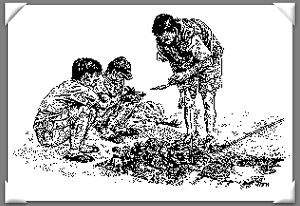
Students analysing samples on the sandy shore day
Sun, sea and sand ü what more could one ask for
on a trip into the great outdoors? Well, some rocky shore would be good,
with animals by the dozen and spectacular scenery. These requirements
were more than adequately fulfilled by the first year Environmental Biology
field course. I had been kindly invited by my colleagues in the Department
of Ecology & Biodiversity to take part on this course as a visiting
academic.
Almost immediately, we were thrown in at the deep end ü some of us more literally than others ü as we made the first investigations of the week, looking at a local stream.
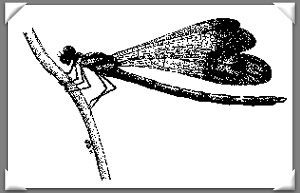
Rhynocypha perforata, one of many odonates
that were captured on the stream day
Over that week, four different habitats were explored,
all aquatic, most marine. This
may be regarded as a little biased, but it does make some sense. Students
are given the opportunity to compare four apparently similar environments,
and discover through exploration that although general patterns may
Two features strike a biologist from temperate
climes about Hong Kong’s habitats. One
is the great variety of organisms and the odd places that some groups
turn up in when compared to similar environments back in Britain. A notable
example is the presence of crabs in freshwater streams: mitten crabs (Eriocheir
sinensis) have recently been introduced to the UK, but they are an
uncommon occurrence and I have yet to see my first ‘British’ one in the
wild. The other feature is the
large amount of rubbish, which is everywhere in Hong Kong.
This really detracts from the enjoyment of any ecology trip, for
fun or work, not to mention the hazards it presents ü picking your way
through loads of rubbish in order to find interesting creatures is not
my idea of a great time!
However, if you are a self-confessed zoology nut
like me, the animals will win through in the end. A number of species
seen on the course come to the fore as ‘favourites’ for me, some of which
I’ll include below. Be warned, as you may notice a theme.
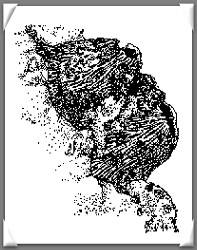
Barnacles of the genus Tetraclita,
rocky shore day
Fiddler-crabs come at the top of this list, marvellous
pieces of evolution with semaphore-waving behaviour designed to intimidate
their opponents and excite potential mates. I saw at least two species,
the most notable individuals being at Hoi Sing Wan (Starfish Bay), i.e.
the mid-shore Uca lactea with its brown carapace and milky-white
claw, and the high-shore, much more intensely decorated, U. chlorophthalmus,
one particularly bright individual of which I found cowering among the
sparse stalks of some seaside herbage. Crabs abound here, among them the
soldier-crabs Mictyris longicarpus, scurrying over the sand in
their search for food in the sediment, looking for all the world like
miniature mauve battalions on some raiding mission ü hence their name,
I would imagine. I even see my first wild horseshoe crabs on this shore.
Not really crabs, these animals are more closely related to spiders
and are similar in general appearance to that most famous extinct arthropod
group, the trilobites, although they are not closely related. Nothing
like any of these animals occurs in Britain ü most of our intertidal species
are shore-crabs with ‘typical’ crab-like dimensions, and hence are similar
in general appearance to rock-crabs (family: Grapsidae).
Fish also figure highly in my list of notables
as, for the first time, I encounter wild puffers (Fugu vermicularis),
among other delights. I only find a tiny individual, but the adrenaline
rush is enough to make it worthwhile!
I do have to mention the Littoraria winkles
of the mangroves because, while Littorina (a related genus) are
not exactly high up on my list of favourite animals, as my friends will
no doubt tell you, I have always wanted to see the mangrove versions of
this family. Now I have - two species in fact, very different from each
other in sculpture if not in apparent shape or patterning.
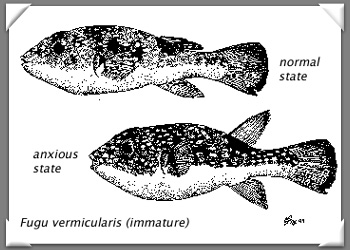
Juvenile common puffer (Fugu vermicularis), before
(above) and after (below) becoming agitated
Finally, I must make space for the rocky shore.
While no particular animal stands out as being very notable in itself,
it has to be said that these rocky, spray-soaked places, as ever, are
my favourite habitats. It was with this child-like excitement that I greeted
the last day of trips, to Hoi Sing Wan’s rocky side. The shear number
of animals visible to the casual observer is remarkable. Certainly, the
rocky intertidal doesn’t have brightly-coloured dragonflies, nor soldier-crabs,
nor even a notable array of fish species. However, it does have rock-crabs
(Grapsus spp.). It also has porcelain crabs (Petrolisthes),
and giant barnacles (Tetraclita spp.), hordes of mussels,
limpets and, dare I say it, winkles (mostly Nodilittorina). One
major difference that I should mention between the rocky shores of Hong
Kong and those of Britain at this time of year is the lack of seaweed
on the former, at least on the site visited ü Britain’s rocky coastline
would be dominated by great drifts of wracks (Ascophyllum, Fucus);
Ulva, Porphyra, Enteromorpha and Corallina
would fill rock pools with a wide array of colours and shades, whilst
out in the lower intertidal / subtidal region would be forests of various
kelps (Laminaria spp.). On the field trip I encountered only two
species of marine algal growth, both encrusting and therefore not exactly
what you’d call exciting to look at ü and one of these was a cyanobacterium!
I enjoyed the trip, but did the students? I think
that the answer has to be ‘yes’. They also learned a lot. The enthusiasm with which most tackled the course
was exemplified by the posters, which were generally well thought out
and, for the most part, contained a lot of useful ecological information.
Hordes of smiling faces greeted us every day, while the atmosphere was
always friendly and relaxed, with students eager to learn and not, on
the whole, worried about getting wet or dirty. I think that a lot of useful
field techniques were also learned, from simple censusing to catching
fast-flying insects. Could they identify the animals if they were sent
into the field again on their own? That I’m not so sure about, at least
not without expert help, but the enthusiasm is there, which is the main
thing.
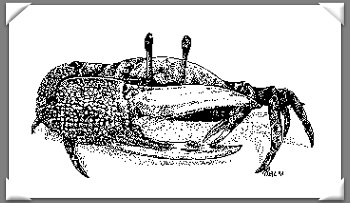
Uca lactea, Hoi Sing Wan
| P.23-24 |
By
the way
by
R. D. Hill
The notes concerning
last season’s typhoons and their effects jogged my memory concerning visits
to two of my field sites (for erosion control). One is on a hillside near
Shau Kei Wan, on the south side of the Eastern Corridor, opposite Lei
Yue Mun. The other is at Mt. Butler, adjoining the Bomb-disposal Range.
At the former, but not at the latter, it was very noticeable that the
tree-crowns were mostly browned off and dying on the side facing the sea.
York was a fairly dry typhoon and it seems likely that a fair amount of
sea salt was entrained and deposited dry upon leaf surfaces on the windward
side of tree-crowns. The “salt-storm” phenomenon is well-known along coasts
where salt is carried inland by prevailing winds, deposited upon leaves
and, in the partial ü or complete ü absence of rain is not washed off.
Such dry deposition quickly damages the tissues, presumably at least in
part because of desiccation.
In Hong Kong storms are usually accompanied by a great deal of rain so that such salt as may be deposited would soon be washed off. The salts would be added to the soil, of course, though in what quantity, with what residence-time and what effects no one knows. In other places sea salt has been detected a 100 km inland, while close to the sea annual additions of up to 40 t ha yr have been measured. Maybe there’s a nice little study here for a chemically-minded ecologist.
| P.24 |
|
Porcupine! |
 Copyright © 2000 |
